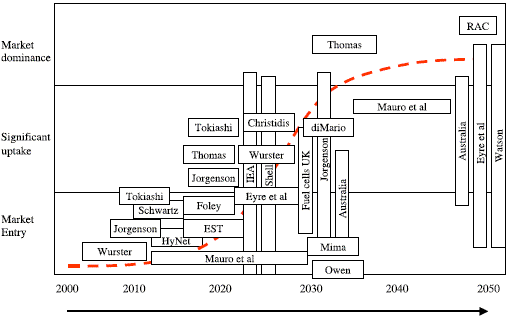McDowall,W. and Eames,M.(2006): Forecasts,
scenarios, visions, backcasts and roadmaps to the hydrogen economy:
A review of the hydrogen futures literature. Energy Policy,
34, 1236-1250.
『水素経済への予想・筋書・理想像・未来像・指針:水素の将来に関する文献のレビュー』
『Abstract
Scenarios, roadmaps and similar foresight methods are used to
cope with uncertainty in areas with long planning horizons, such
as energy policy, and research into the future of hydrogen energy
is no exception. Such studies can play an important role in the
development of shared visions of the future: creating powerful
expectations of the potential of emerging technologies and mobilising
resources necessary for their realisation.
This paper reviews the hydrogen futures literature, using a six-fold
typology to map the state of the art of scenario construction.
The paper then explores the expectations embodied in the literature,
through the ‘answers’ it provides to questions about the future
of hydrogen. What are the drivers, barriers and challenges facing
the development of a hydrogen economy? What are the key technological
building blocks required? In what kinds of futures does hydrogen
become important? What does a hydrogen economy look like, how
and when does it evolve, and what does it achieve?
The literature describes a diverse range of possible futures,
from decentralised systems based upon small-scale renewables,
through to centralised systems reliant on nuclear energy or carbon-sequestration.
There is a broad consensus that the hydrogen economy emerges only
slowly, if at all, under ‘Business as Usual’ scenarios. Rapid
transitions to hydrogen occur only under conditions of strong
governmental support combined with, or as a result of, major ‘discontinuities’
such as shifts in society's environmental values, ‘game changing’
technological breakthrough, or rapid increases in the oil price
or speed and intensity of climate change.
Keywords: Scenario building; Hydrogen economy; Roadmapping』
1. Introduction
2. Review methology
3. A typology of hydrogen futures
3.1. Forecasts
3.2. Exploratory scenarios
3.3. Technical scenarios
3.4. Visions
3.5. Backcasts & pathways
3.6. Roadmaps
4. What does the literature say about a hydrogen future?
4.1. What are the drivers of a hydrogen economy?
4.2. Barriers & challenges
4.3. In what kinds of future does hydrogen become important?
4.3.1. Does a hydrogen future rely on ‘step-changes’?
4.4. What does the hydrogen economy look like?
4.4.1. Decentralised architectures
4.4.2. Centralised architectures
4.4.3. Each architecture is dependent on key technological building
blocks
4.5. Evolution of hydrogen economies
4.6. Early learning: the importance of niche markets in technology
development
4.7. When does a hydrogen economy emerge?
4.8. Policies
4.9. What does a hydrogen economy achieve?
5. Discussion and conclusions
5.1. Futures in hydrogen: the state of the art
5.1.1. What is wrong with the hydrogen futurist's toolbox?
5.1.2. What can we learn from the hydrogen futures literature?
5.2. Conclusion: no hydrogen economy, but many hydrogen economics
Acknowledgements
References

Fig. 3. Shows estimated dates for a transition to a fuel
cell based transport system.
〔McDowall,W. and Eames,M.(2006): Forecasts, scenarios,
visions, backcasts and roadmaps to the hydrogen economy: A review
of the hydrogen futures literature. Energy Policy,
34, 1236-1250.から〕 |
- The Australian Government(2003): National Hydrogen
Plan. Report for the Department of Industry & Resources.
- Christidis,P., Pelkmans,L., De Vlieger,I., Cowan,R., ulten,S.,
Morato,A., Azkarte,G. and Estevan,R.(2003): Trends
in Vehicle and Fuel Techmologies: Scenarios for Future Trends.
EC Joint Research Centre.
- Di Mario,F., Lacobazzi,A., Infusion,R. and Mattucci,A.(2003):
Socio-economic aspects of hydrogen economy development.
European Commission Joint Research Centre EUR 20668.
- Energy Savings Trust (EST) (2002): Pathways
to Future Vehicles: A 2020 Strategy. Energy Savings Trust,
London.
- Eyre,N., Ferguson,I. and Mills,R.(2002): Fuelling Road
Transport; Implications for Energy Policy. Report for
the Energy Savings Trust, London.
- Foley,J.(2001): H2: Driving the
Future. Institute for Public Polocy Research report,
London.
- Fuel Cells UK(2003): Fuel
Cell Visions for the UK. Synnogy Ltd., Thorpe Waterville,
UK.
- HuNet(2004): Towards a European Hydrogen Roadmap, Executive
Report. L-B-Systemtechnik GmbH, Ottobrunn, Germany.
- IEA(2003): Energy
to 2050: scenarios for a sustainable future. OECD,
Paris.
- Mauro,R., Serfass,K.A. and Leach,S.(1996): A bridge to
a sustainable hydrogen future: reassessing the transition.
Hydrogen Energy Progress XI. Proceedings of the World Hydrogen
Energy Conference, Stuttgart, Germany.
- Mima,S. and Criqui,P.(2003): The future of fuel cells
in a lomg-term inter-technology competition framework. In:
Avadikyan,A., Cohendet,P. and Heraud,J.A.(Eds.), The Economic
Dynamics of Fuel Cell Technologies. spring, Berlin, 42-78.
- Owen,N,J, and Gordon,R.L.(2002): Carbon to Hydrogen:
Roadmaps for Passenger Cars. Ricardo Consulting report
for Departments of Transport and Trade and Industry, London.
- RAC(2002): Motoring Towards 2050. RAC Foundation,
London.
- Schwartz,P.(1996): The Art of the Long View.
Currency Doubleday, New York.
- Shell(2001): Energy
needs, choices and possibilities: scenarios to 2050.
Global Business Environment, shell International.
- Thomas,C.E., James,B.D. and Lomax,F.D.(1998): Market Penetration
models for FCVs. International Journal of Hydrogen Energy,
23, 949-966.
- Toshiaki,A.B.E.(2003): Japan's Hydrogen Vision. Presented
at Toward Hydrogen, IEA Renewable energy working party seminar,
March 3rd, 2003.
- Watson,W.J., Tetteh,A., Dutton,G., Bristow,A., Kelly,C. and
Page,M.(2004): Hydrogen Futures to 2050. Tyndall
working paper 46.
- Wurster,R.(2002): Pathways
to a Hydrogen Refuelling Infrastructure: Between Today and 2020.
L-B Systemtechnik Gmbh, Ottobrun, Germany.
戻る
